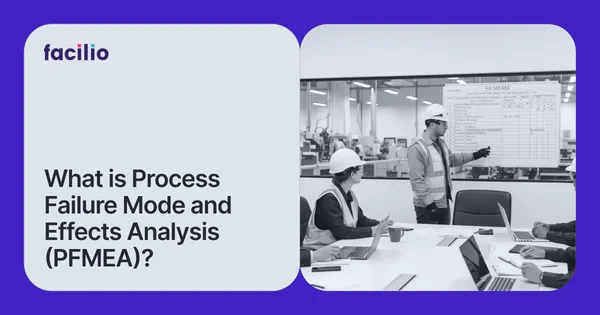Process Failure Mode and Effects Analysis (PFMEA) gives you a systematic lens to surface and prioritize hidden process risks — before they blow up into downtime, quality defects or safety incidents. PFMEA is essentially a process-oriented cousin of FMEA: while FMEA broadly tackles failure risk (in design, systems, products), PFMEA zeros in on processes.
PFMEA equips maintenance, operations, and quality teams with a common framework that ranks risks by severity, likelihood, and detectability. That ranking then guides where you must act first.
In short: PFMEA is your early-warning system for process risk. Let’s unpack it in full.
What is PFMEA?
At its core, PFMEA is a structured, qualitative risk assessment method applied to processes. Its goal: identify failure modes, evaluate their impacts, rank them, and propose mitigation — all before failures actually happen.
- "Failure mode": a way in which a process step could go wrong (e.g. incorrect torque, misalignment, missing input)
- "Effect": the consequence if that failure happens (e.g. product defect, safety hazard, downstream stoppage)
- "Causes": what drives that failure (e.g. worn tooling, human error, variation in raw material)
PFMEA is a specialization under the broader FMEA umbrella. While FMEA can cover designs, systems, and components, PFMEA zeroes in on processes — especially manufacturing, assembly, or operational workflows. (6sigma.us)
PFMEA encourages cross-functional teams (ops, quality, maintenance) to think together, translate tacit knowledge of what “can go wrong” into documented risk, and then act.
What are the types of PFMEA
PFMEA isn’t one-size-fits-all. Depending on context, you might see these “types” or flavors:
- Manufacturing PFMEA — applied to shop floor steps (machining, assembly, welding)
- Transactional or Administrative PFMEA — in non-physical flows (order entry, logistics, service)
- Change / Revision PFMEA — applied when an existing process is altered (new equipment, layout, method)
- Subprocess PFMEA — focusing on critical subprocesses or handoffs
You may not label them “type 1, type 2,” but the point is to fit PFMEA to your domain of risk. A process in production has different failure exposers than a service process, so your PFMEA must adapt.
How does PFMEA work? / Why perform
PFMEA centers on three key ratings: Severity (S), Occurrence (O), and Detection (D). Their product gives you the RPN (Risk Priority Number) — the risk score you’ll use to order priorities.
RPN = Severity × Occurrence × Detection
Failures with high RPNs get your attention.
Why do this exercise? Because resources are finite. You can’t fix everything. PFMEA helps you triage your investments. Plus:
- It aligns teams around a shared risk view
- It forces explicit discussion of “what ifs”
- It gives defensible rationale for maintenance / improvement priorities
- It becomes a “living document” you revisit as processes evolve
One caveat: the ratings are subjective unless you calibrate them with data and team consistency. Also, don’t get tunnel vision on RPN — sometimes qualitative judgment trumps numbers.
PFMEA Examples: Turning Risk into Action
Let’s bring this to life with a simplified example (fictional, but realistic):
In this example, “Overfill” gets highest RPN (96), so it becomes top priority for controls or redesign.
Also, in more advanced use you could map control plans once mitigation is applied, then re-rate detection or occurrence to see if RPN drops suitably.
Who Benefits from PFMEA?
PFMEA is not just for “quality folks” — it’s useful for any stakeholder in processes. Some key beneficiaries:
- Reliability / Maintenance Teams: to anticipate failures before breakdowns occur
- Process / Production Engineers: when designing or improving process steps
- Quality / Compliance Teams: to validate risk mitigation, audits
- Operations Leadership: to prioritize capex, preventive maintenance, resource allocation
- Safety / EHS Teams: because process failures often have safety implications
If you span multiple domains (mechanical, electrical, logistics), PFMEA gives you a common risk language.
Why and When to Use PFMEA: Timing & Triggers
You don’t run PFMEA on every process, every day. Use it when risks are high, change is incoming, or failure costs are unacceptable. Here are triggers:
- New process design or introduction — do PFMEA before you go live
- Process changes — new equipment, layout, materials, or method
- Recurring failures or defects — when issues reappear, do a root PFMEA
- Regulatory / safety mandates — when compliance demands documented risk analysis
- Continuous improvement reviews — revisit PFMEA periodically
The idea: the moment your process changes (even subtly), your risk map must too.
Step-by-Step Guide to Conducting PFMEA
Here’s a practical sequence you can follow (adapt to your context):
- Define scope & objectives
- Which process, which boundaries (start, end)
- What customers, what outputs matter most
- Assemble cross-functional team
- Map the process / create flow diagram
- Visualize each step, input, output, decisions
- Include handoffs, waiting steps, exceptions
- List functions, failure modes, and effects
- For each process step: ask “how can this fail?”
- Define effect(s) of failure on next steps, output, customer
- Identify causes & existing controls
- For each failure mode, determine root causes
- Document how you currently detect or prevent it
- Assign severity, occurrence, and detection ratings
- Use reference scales or past data
- Try to calibrate with your team for consistency
- Compute RPNs
- Multiply S × O × D
- Rank failure modes by risk
- Propose corrective actions
- For high RPNs, propose mitigation (design change, additional checks, automation)
- Update control measures
- Re-rate & recalc RPN after mitigation
- Measure the risk reduction
- Review, monitor, and update
- Periodically revisit the PFMEA
- When process changes, update the document
- Communicate results and integrate into workflows
- Use outcomes in maintenance plans, SOPs, KPI tracking
Trust the process, but don’t become captive to it. The goal is usable insight, not paperwork.
Top Benefits & Drawbacks of PFMEA
Benefits
- Helps you target the highest impact failure modes first
- Promotes cross-functional alignment and risk transparency
- Provides defensible prioritization, not just gut feel
- Supports preventive maintenance strategy
- Reduces downtime, defects, safety events
Drawbacks / Challenges
- Can be laborious and resource-intensive upfront
- Ratings may be too subjective if team isn’t calibrated
- Without updates, the PFMEA becomes outdated
- Over-dependence on numerical RPNs may mask nuanced risk
- Requires buy-in; without accountable owners, actions stall
PFMEA Use Cases Across Industries
PFMEA has broad relevance — any domain that values process reliability and risk control:
- Automotive — for assembly, welding, torqueing, painting
- Pharma / Biotech — for batch processing, contamination controls
- Electronics — SMT, soldering, cleanroom steps
- Food & Beverage — hygiene, cross-contamination, fill/pack lines
- Aerospace / Defense — where failure costs are extremely high
In each, teams use PFMEA to improve yield, comply with standards, and reduce operational surprises.
How CMMS Supports PFMEA
Pairing PFMEA with a smart CMMS (Computerized Maintenance Management System) platform transforms your risk analysis into action:
- Historical data integration — use past failure / downtime data to refine occurrence ratings
- Triggering workflows — link PFMEA-derived corrective tasks to work orders
- Tracking action status — monitor whether mitigation actions are implemented and effective
- Dashboards & alerts — visualize risk levels evolving over time
- Iteration & review — version control, audit trails, updates anchored in data
What is a PFMEA Worksheet?
A PFMEA worksheet is your “risk register” document. It houses all the details, structured step by step. Typical columns include:
- Process Step / Function
- Failure Mode
- Effect(s) of Failure
- Severity (S), Occurrence (O), Detection (D) ratings
- RPN
- Existing Controls
- Recommended Mitigations / Actions
- Re-rating (post actions)
It often ties to your control plan: the set of controls, checks, inspections, and error detection steps you put in place.
A good worksheet makes the logic of your PFMEA transparent, auditable, and evolvable.
What is a Process Flow Diagram and Why It’s Important
Before you can analyze failure modes, you need to see the process. A Process Flow Diagram (PFD) maps each step, decision node, input/output, handoff, etc.
Why it’s foundational:
- Aligns teams on what the process really is
- Ensures you don’t skip hidden steps (waiting, transitions)
- Helps define boundaries (what’s in vs. out)
- Supports clarity when you link failure modes to actual steps
In PFMEA, the better your flow diagram, the fewer blind spots you’ll have when you assess risk.
Bringing PFMEA to Life With Intelligent Detection,
PFMEA (Process Failure Mode and Effects Analysis) is not just a quality exercise. It’s your strategic lever against surprise failure. When done right, it systematizes risk thinking, aligns cross functions, and drives the highest-impact improvements first.
But PFMEA only pays if it’s alive. It must be maintained, revisited, married into your CMMS and acted upon. With that discipline, PFMEA stops being a “nice to have” checklist and becomes a central tool in your reliability and operations playbook.
If you want to take it a step further, pairing PFMEA discipline with modern fault detection and diagnostics can close the loop between risk assessment and real-time action.
Facilio’s intelligent FDD software helps teams surface anomalies earlier, validate PFMEA assumptions with live building data, and turn potential failure modes into timely interventions.
Together, PFMEA and intelligent FDD can shift your operations from reactive to confidently predictive — setting your team up for a future where surprises get smaller, uptime gets stronger, and continuous improvement becomes the norm.


